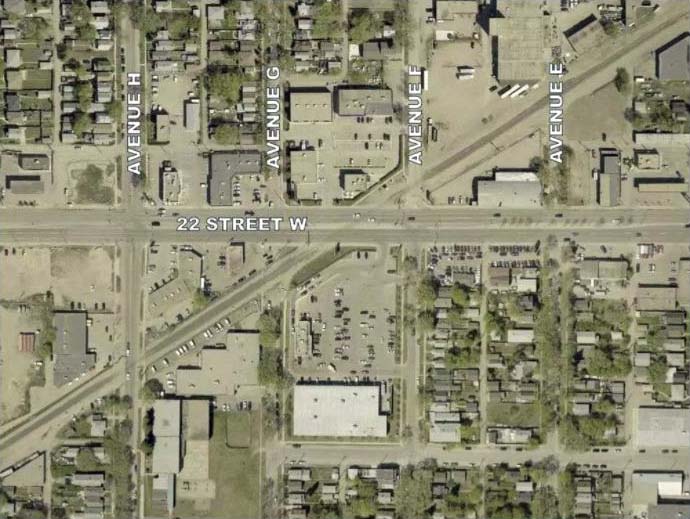

between Avenue F and Avenue G - Date/Photographer unknown.
Saskatoon Saskatchewan - On Monday, city council's transportation committee will consider a consultant's report on how to address railway
crossing delays in Saskatoon.
What does the report recommend?
It argues that city hall should abandon the idea of addressing railway crossing delays by building underpasses and overpasses and focus instead on relocating
the Canadian Pacific (CP) line outside of city limits.
The study looked at relocating the CP line that slices through the city versus building underpasses/overpasses at nine locations.
The cost of relocating the CP line was higher than the overpass/underpass options, $589.7 million versus $374.4 million, but the overall economic benefits of
relocation over 30 years outweighed the other option by $392.1 million compared to $218 million.
Is rail relocation realistic?
Many would say no, including Mayor Charlie Clark.
In one of Clark's first meetings as mayor, he questioned whether it was worthwhile to study relocating rail lines since it seemed an unrealistic option due to
cost.
Clark said in November 2016 that he had never heard an estimate below $1 billion for rail relocation.
Coun. Darren Hill said at the same meeting that the estimates he's heard pegged the cost at between $2 billion and $3 billion.
Those estimates may have included both CP and Canadian National (CN) lines.
Clark's opponent in the 2016 election, former mayor Don Atchison, championed the idea of rail relocation during his unsuccessful re-election
campaign.
Where would the CP rail line relocate?
The report suggests four possibilities, three south of the city, and one north.
The north route would run parallel to the proposed Saskatoon Freeway, but has been deemed unlikely due to higher cost.
Three options would involve building a bridge to cross the South Saskatchewan River at an estimated $79 million.
The other possibility is shared use or expansion of the existing CN Railway Bridge, just south of the Gordie Howe Bridge.
Are those locations realistic?
All the proposed relocations would involve land located in the Rural Municipality of Corman Park.
The proposed Saskatoon Freeway was originally called the Perimeter Highway and envisioned as a loop around the city.
The southern part of the loop was scrapped by the provincial government because too much Corman Park land was already developed.
It's difficult to see how a proposed relocated railway would not face the same obstacles, if not more.
In one of the scenarios, a train bridge would be built just north of Victor Road south of the city.
Another option envisions a bridge just north of Grasswood Road.
Who would pay for relocation?
Even if one accepts the consultant's estimate of just under $600 million to relocate the CP line, that's far beyond the city's financial ability.
If either the railways or the federal government agreed to pay for rail relocation in Saskatoon, it's easy to imagine every municipality in Canada with a rail
line running through it demanding the same.
That's been the long-standing barrier to rail relocation nationwide.
Why is the city still thinking about relocation if the costs outweigh the benefits?
There are less quantifiable benefits, like stopping the shipping of hazardous materials through the middle of Saskatoon and preventing delays for emergency
response vehicles.
How will this effect the city's proposed bus rapid transit (BRT) system?
Finding a solution to railway crossings has been one of the major challenges when establishing BRT systems since the goal is predictable, high-frequency,
routes.
The key obstacles for Saskatoon's proposed BRT are CP lines that cross 22nd Street West and Preston Avenue.
The city is proposing technology to make bus riders aware of train delays, but that won't stop the delays.
Interestingly, the same consultant, that studied railway crossing delays, HDR Corporation, is planning Saskatoon's BRT system.
Could the city build overpasses/underpasses at some locations?
That could be one solution without waiting for rail relocation that may never come.
In the cost-benefit analysis, the crossings at 22nd ($48 million) and Preston ($26.5 million) yield the highest comparable benefits of $46.5 million and $23.3
million, respectively.
Phil Tank.
under the provisions in
Section 29 of the Canadian
Copyright Modernization Act.

